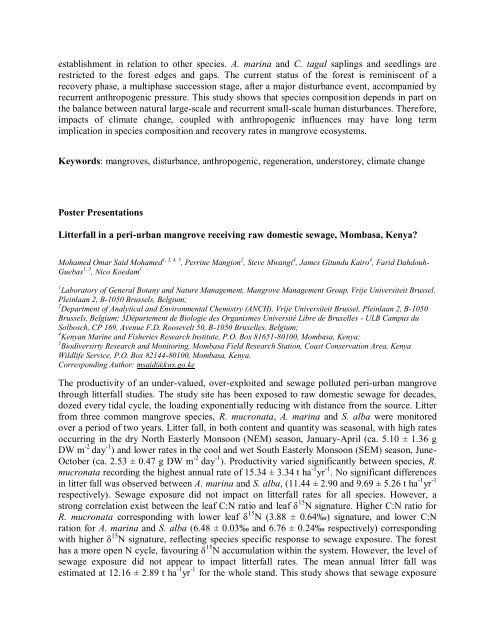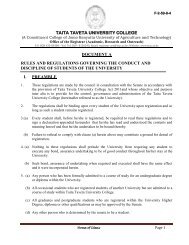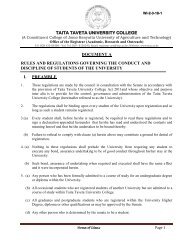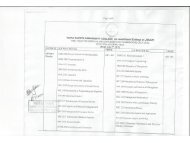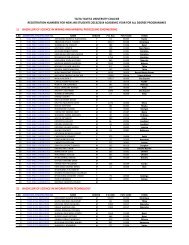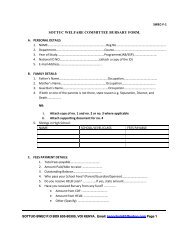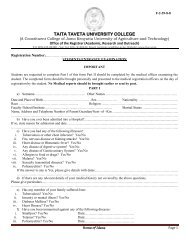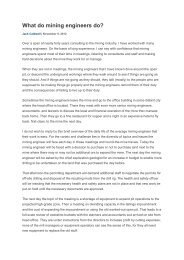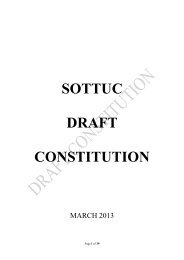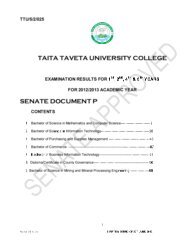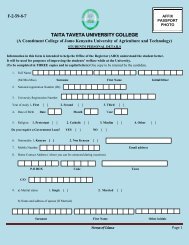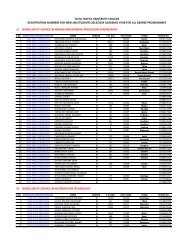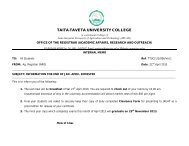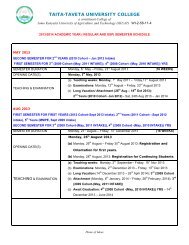Conference Book of Abstracts - Taita Taveta University College
Conference Book of Abstracts - Taita Taveta University College
Conference Book of Abstracts - Taita Taveta University College
- No tags were found...
Create successful ePaper yourself
Turn your PDF publications into a flip-book with our unique Google optimized e-Paper software.
establishment in relation to other species. A. marina and C. tagal saplings and seedlings arerestricted to the forest edges and gaps. The current status <strong>of</strong> the forest is reminiscent <strong>of</strong> arecovery phase, a multiphase succession stage, after a major disturbance event, accompanied byrecurrent anthropogenic pressure. This study shows that species composition depends in part onthe balance between natural large-scale and recurrent small-scale human disturbances. Therefore,impacts <strong>of</strong> climate change, coupled with anthropogenic influences may have long termimplication in species composition and recovery rates in mangrove ecosystems.Keywords: mangroves, disturbance, anthropogenic, regeneration, understorey, climate changePoster PresentationsLitterfall in a peri-urban mangrove receiving raw domestic sewage, Mombasa, Kenya?Mohamed Omar Said Mohamed 1, 2, 4, 5 , Perrine Mangion 2 , Steve Mwangi 4 , James Gitundu Kairo 4 , Farid Dahdouh-Guebas 1, 3 , Nico Koedam 11 Laboratory <strong>of</strong> General Botany and Nature Management, Mangrove Management Group, Vrije Universiteit Brussel,Pleinlaan 2, B-1050 Brussels, Belgium;2 Department <strong>of</strong> Analytical and Environmental Chemistry (ANCH), Vrije Universiteit Brussel, Pleinlaan 2, B-1050Brussels, Belgium; 3Département de Biologie des Organismes Université Libre de Bruxelles - ULB Campus duSolbosch, CP 169, Avenue F.D. Roosevelt 50, B-1050 Bruxelles, Belgium;4 Kenyan Marine and Fisheries Research Institute, P.O. Box 81651-80100, Mombasa, Kenya;5 Biodiversirty Research and Monitoring, Mombasa Field Research Station, Coast Conservation Area, KenyaWildlife Service, P.O. Box 82144-80100, Mombasa, Kenya.Corresponding Author: msaid@kws.go.keThe productivity <strong>of</strong> an under-valued, over-exploited and sewage polluted peri-urban mangrovethrough litterfall studies. The study site has been exposed to raw domestic sewage for decades,dozed every tidal cycle, the loading exponentially reducing with distance from the source. Litterfrom three common mangrove species, R. mucronata, A. marina and S. alba were monitoredover a period <strong>of</strong> two years. Litter fall, in both content and quantity was seasonal, with high ratesoccurring in the dry North Easterly Monsoon (NEM) season, January-April (ca. 5.10 ± 1.36 gDW m -2 day -1 ) and lower rates in the cool and wet South Easterly Monsoon (SEM) season, June-October (ca. 2.53 ± 0.47 g DW m -2 day -1 ). Productivity varied significantly between species, R.mucronata recording the highest annual rate <strong>of</strong> 15.34 ± 3.34 t ha -1 yr -1 . No significant differencesin litter fall was observed between A. marina and S. alba, (11.44 ± 2.90 and 9.69 ± 5.26 t ha -1 yr -1respectively). Sewage exposure did not impact on litterfall rates for all species. However, astrong correlation exist between the leaf C:N ratio and leaf δ 15 N signature. Higher C:N ratio forR. mucronata corresponding with lower leaf δ 15 N (3.88 ± 0.64‰) signature, and lower C:Nration for A. marina and S. alba (6.48 ± 0.03‰ and 6.76 ± 0.24‰ respectively) correspondingwith higher δ 15 N signature, reflecting species specific response to sewage exposure. The foresthas a more open N cycle, favouring δ 15 N accumulation within the system. However, the level <strong>of</strong>sewage exposure did not appear to impact litterfall rates. The mean annual litter fall wasestimated at 12.16 ± 2.89 t ha -1 yr -1 for the whole stand. This study shows that sewage exposure


